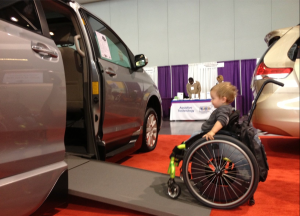There are two options for a person who uses a wheelchair to drive an accessible vehicle. They can drive from their wheelchair and or transfer to the driver’s seat.
Drive from your wheelchair
Driving controls can be adapted to operate from your wheelchair. Usually this means some form of hand controls, though other solutions are possible. There will also be an automatic docking system to secure your wheelchair. All of this will be designed around you and your wheelchair as part of your assessment from an experienced mobility installer.
Safety
- Because you have the opportunity to travel by yourself, you need to be sure you are able to get out in an emergency.
- Typically wheelchair accessible vehicle have fail-safe devices for the doors, ramps/lifts and docking systems. These include battery backups and manual over-rides.
Other drivers
- In many wheelchair accessible vehicles, the front passenger seat can be switched to the drivers side, and there is a docking system on both sides so you can travel as a passenger.
Assessment and training
- If you’re going to be using adapted controls, you will need a professional driving assessment and training.
Transfer to the Driver’s Seat
Some wheelchair users prefer to transfer to a driving seat because they find it more comfortable or easier to drive. Sometimes it’s necessary because your wheelchair may not be suitable for driving. Using the standard car seat also means that you don’t need to fit a specialist seat belt.
By contrast, transferring into the driver seat may not be suitable if you have a specialist seating system in your wheelchair and may be difficult if you have limited mobility.
Wheelchair accessible vehicles can be adapted to allow you to enter with your wheelchair or scooter (by ramp or lift), secure the wheelchair or scooter in the vehicle, and then transfer to the driving seat. You can replace the standard car seat with one that swivels and slides so that you can transfer into it more easily.
Safety
- You will need a docking system for securing the wheelchair – you need to be able to do this by yourself.
- Because you may be traveling by yourself, you need to be sure you will be able to get out in an emergency.
Transferring
- Transferring between the wheelchair and the seat does take some effort – make sure you can do it even on a bad day.
- Make sure there is enough room in the vehicle to let you transfer comfortably and that there are handholds and supports where you need them. You may need to fit extra hand rails or other supports.
Assessment and training
- If you’re going to be using adapted controls, you will need a professional driving assessment and training.

